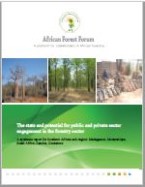This study was aimed at producing information that will be used by relevant stakeholders in facilitating the development of public-private sector partnerships in forestry involved in value addition to wood and non-wood forest products in Southern African region; specifically for five countries: Madagascar, Mozambique, South Africa, Zambia, and Zimbabwe. Also, the study identifies promising public-private partnership (PPP) models/approaches for forest compatibility with sustainable livelihoods that addresses both social and environmental concerns and contribute to more sustainable, equitable and productive private sector development. The contribution of the forestry sector to livelihood support and national economy is significant. Forestry sector contributes to the country’s GDP varying from 0.8% (South Africa) to 5.7% (Zambia). The industry has considerable potential for employment and incomes at different levels. In total, in the Southern African region, there was estimated a total of 125 366 employees in primary forest production and 602 966 charcoal producers. In secondary forest production, the number of employees was estimated at 78 186. Since Madagascar, Mozambique and Zambia depend on indigenous forests for their wood products supply they are facing similar concerns. There are various wood and non-wood tree species of commercial importance whose stocks are declining. This underlines the need to manage the forest resources sustainably. Most of the forest resources in these countries are owned by the government. Actors in secondary forest production are mainly small and medium scale enterprises (SMEs) and large companies in the private sector; most of them are in the informal sector. In South Africa and Zimbabwe, most of the commercial forest estate is in private ownership (83% in South Africa). Landowners have property rights and full control over the land and forest resources on it, with limited statutory prohibitions such as felling of indigenous trees and land use changes. In Zimbabwe, the forest sector had had a history of primary and secondary growth, but capacity utilization fell below 20% resulting from power cuts, inadequate competent staff, and obsolete manufacturing plants. Actors are dominated by men, even though women are also increasing their participation in the sector. There is a government’s initiative in South Africa called B-BBEE that can be used as inspiration to the four other countries to effectively address the issue of participation of women in the forest sector, but factors that constrain success of the program should be considered. There is good potential in the Southern African region, for increased public-private partnerships in the forestry sector. There are several successful PPP models relative to community forestry, community afforestation, value addition in primary and secondary processing, leasing and concession. However, supporting measures are needed, like: (i) sustainable management of forest resources, (ii) land tenure security, (iii) promotion of associations of private companies in order to defend/articulate the interests of the members, (iv) strengthening of the private investment environment in the forest sector, (v) strengthening of ties between organizations, companies and communities in order to link with emerging markets, (vi) providing incentives for the creation of PPPs in the production, (vii) value addition and marketing of forest products and (viii)empowerment of stakeholders in PPP negotiation, and promotion of benefit sharing system.

